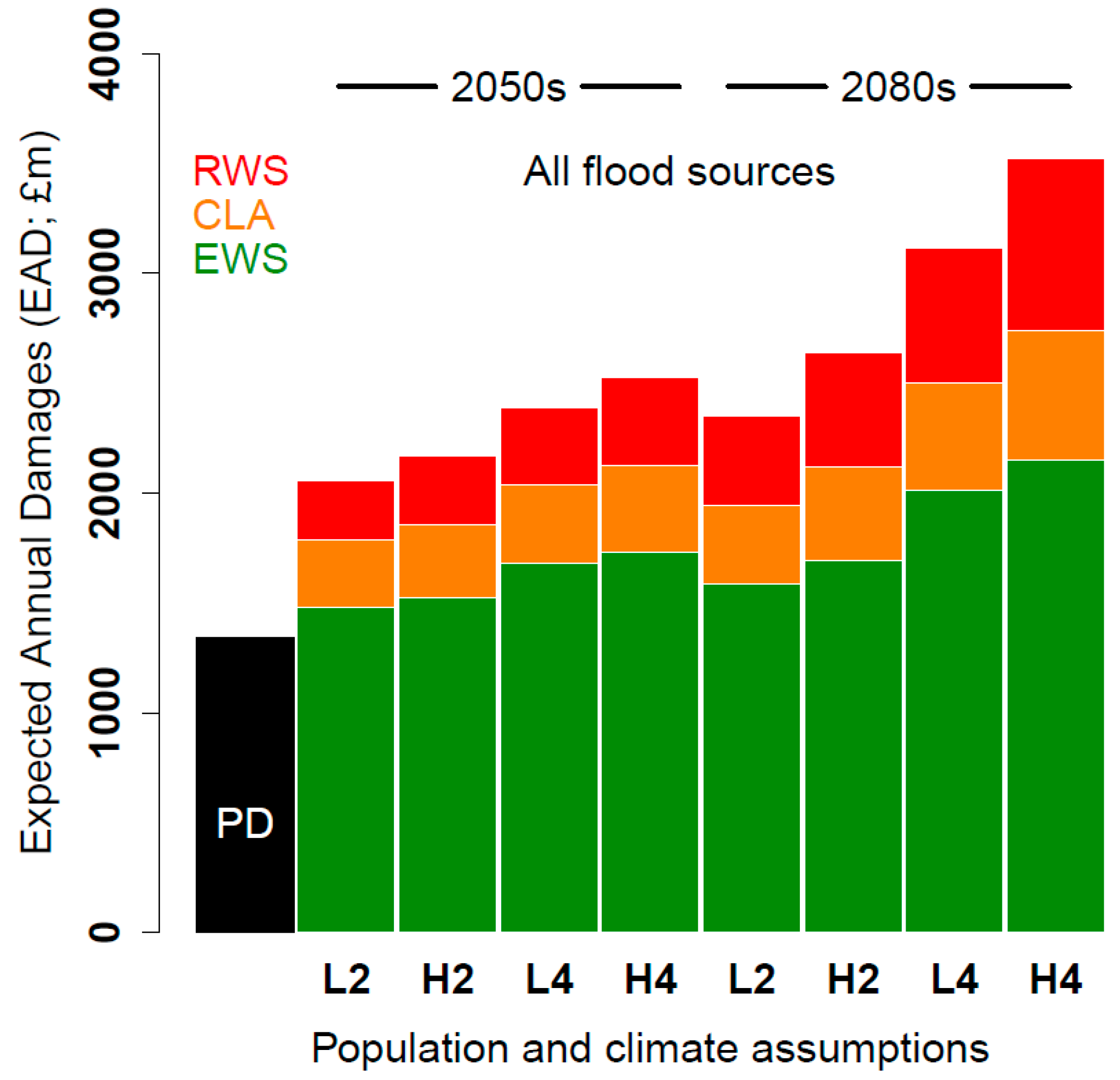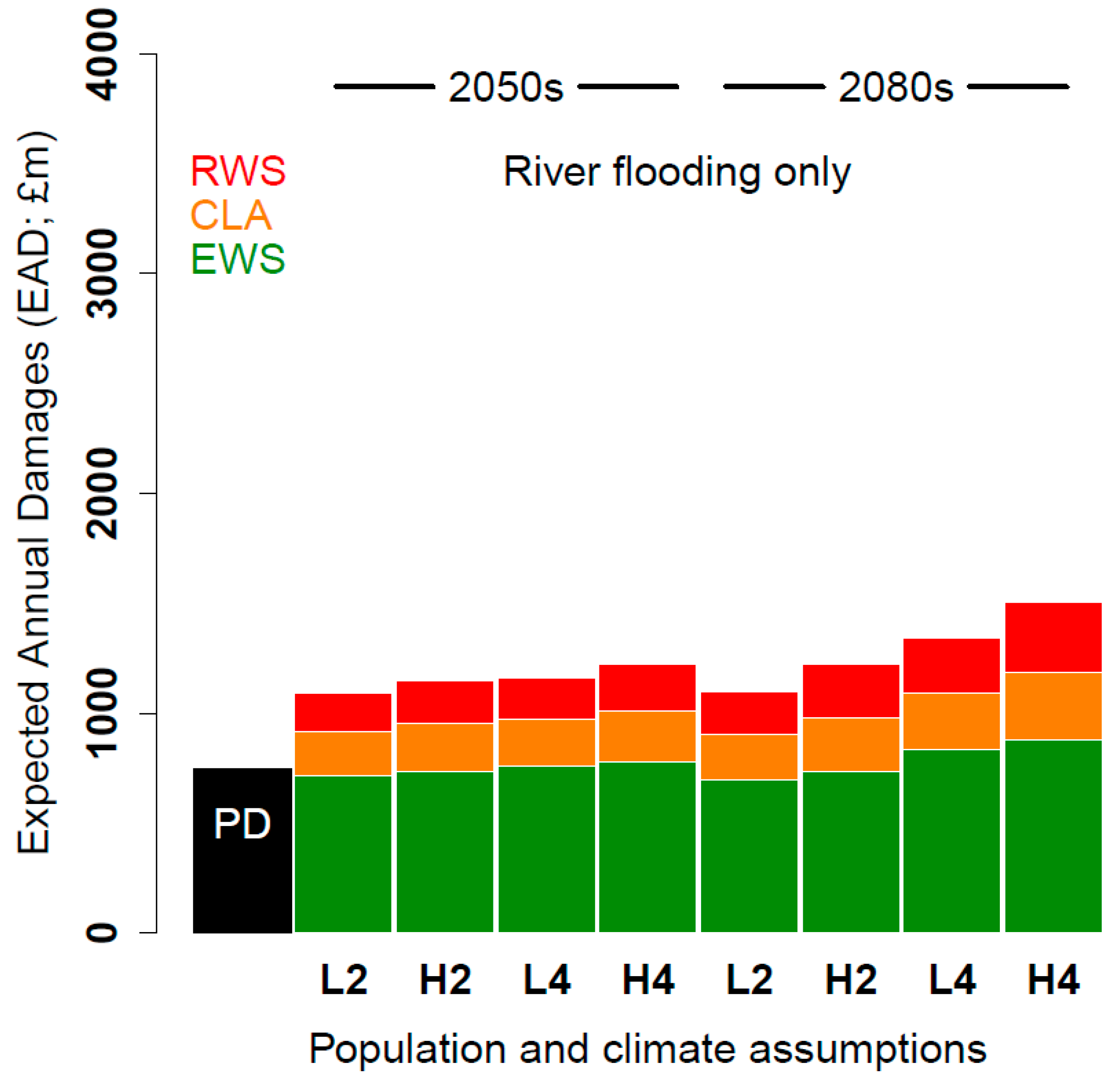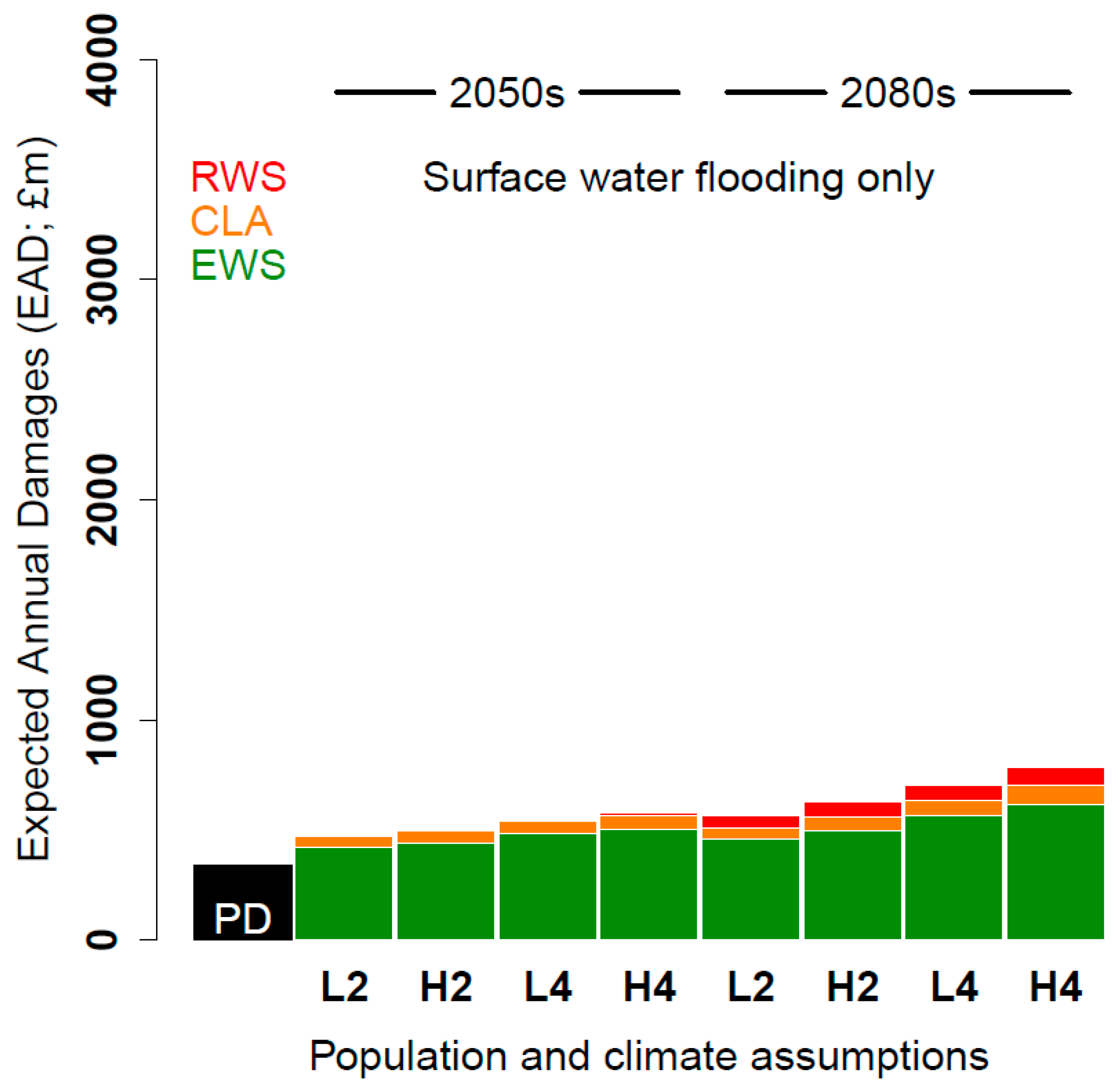Assessing Future Flood Risk and Developing Integrated Flood Risk Management Strategies: A Case Study from the UK Climate Change Risk Assessment
Abstract
1. Introduction
1.1. The Climate Change Adaptation Framework in the UK
1.2. Flood Risk Analyses in the CCRA
1.3. Aims and Structure
- Present the high-level findings from the future flood risk assessment that was conducted for the 2022 CCRA, including the impact of the population, global temperature, and adaptation scenarios that were used.
- Examine the integrated FRM strategies that were incorporated into the assessment.
- Discuss the lessons that can be extrapolated from the UK approach to climate change risk assessment and adaptation strategies more generally.
2. Materials and Methods
2.1. Calculation of Future Flood Risk
2.2. Developing Stakeholder Informed FRM Strategies
- Reduced whole system (RWS)—assumes that recent FRM policy implementation continues but with a lower level of ambition.
- Current level of adaptation (CLA)—extrapolation of recent FRM policy implementation into the future with incorporation of anticipated policy changes; and
- Enhanced whole system (EWS)—as for CLA but interventions are implemented with a higher level of ambition.
3. Results
3.1. All Sources of Flooding (River, Coastal and Surface Water)
3.2. River Flooding
3.3. Coastal Flooding
3.4. Surface Water Flooding
3.5. Impact and Analysis of the RWS, CLA and EWS FRM Portfolios
4. Discussion and Conclusions
4.1. Flood Risk Management Policy Development in Complex Governance Structures
4.2. Uncertainty in Integrated Flood Risk Management Measures
4.3. Conclusions
- The range of EAD projections for all flood sources is projected to increase by between 18% and 160% by the 2080s depending on the assumptions applied on climate change, population growth, and adaptation actions.
- It is possible to reduce EAD from river flood risk by the 2080s.
- The EAD from coastal flood risk has the greatest potential to increase; and
- Adaptation actions have the least potential to impact surface water flood EAD.
Author Contributions
Funding
Institutional Review Board Statement
Informed Consent Statement
Data Availability Statement
Acknowledgments
Conflicts of Interest
References
- IPCC. Climate Change 2022: Impacts, Adaptation and Vulnerability. Contribution of Working Group II to the Sixth Assessment Report of the Intergovernmental Panel on Climate Change; Pörtner, H.-O., Roberts, D.C., Tignor, M., Poloczanska, E.S., Mintenbeck, K., Alegría, A., Craig, M., Langsdorf, S., Löschke, S., Möller, V., et al., Eds.; Cambridge University Press: Cambridge, UK; New York, NY, USA, 2022; p. 3056. [Google Scholar]
- Munich, R.E. Flood Risks on the Rise. Available online: https://www.munichre.com/en/risks/natural-disasters-losses-are-trending-upwards/floods-and-flash-floods-underestimated-natural-hazards.html (accessed on 12 October 2022).
- Environment Agency. Thames Estuary TE2100 Plan; Environment Agency: London, UK, 2022. [Google Scholar]
- HM Government. Climate Change Act 2008; HM Government: London, UK, 2008.
- HM Government. UK Climate Change Risk Assessment: Government Report; HM Government: London, UK, 2012.
- HM Government. UK Climate Change Risk Assessment 2017; HM Government: London, UK, 2017.
- HM Government. UK Climate Change Risk Assessment 2022; HM Government: London, UK, 2022.
- HM Government. The National Adaptation Programme; HM Government: London, UK, 2013.
- Department for Environment, Food and Rural Affairs (Defra). The National Adaptation Programme and the Third Strategy for Climate Adaptation Reporting; Defra: London, UK, 2018.
- Committee on Climate Change. Progress in Preparing for Climate Change—2015 Progress Report to Parliament; Committee on Climate Change: London, UK, 2015. [Google Scholar]
- Committee on Climate Change. Progress in Preparing for Climate Change—2017 Progress Report to Parliament; Committee on Climate Change: London, UK, 2017. [Google Scholar]
- Committee on Climate Change. Progress in Preparing for Climate Change—2019 Progress Report to Parliament; Committee on Climate Change: London, UK, 2019. [Google Scholar]
- Committee on Climate Change. Progress in Preparing for Climate Change—2021 Progress Report to Parliament; Committee on Climate Change: London, UK, 2021. [Google Scholar]
- Russell, A.; McCue, A.J. Is increasing surface water flood risk in a changing climate being managed adequately? An audit of England’s local flood risk management strategies. Clim. Policy 2022. in review. [Google Scholar]
- Environment Agency. National Flood and Coastal Erosion Risk Management Strategy for England; Environment Agency: London, UK, 2020.
- Brown, K.; DiMauro, M.; Johns, D.; Holmes, G.; Thompson, D.; Russell, A.; Style, D. Turning risk assessment and adaptation policy priorities into meaningful interventions and governance processes. Phil. Trans. R. Soc. A 2018, 376, 20170303. [Google Scholar] [CrossRef] [PubMed]
- Warren, R.F.; Wilby, R.L.; Brown, K.; Watkiss, P.; Betts, R.A.; Murphy, J.M.; Lowe, J.A. Advancing national climate change risk assessment to deliver national adaptation plans. Phil. Trans. R. Soc. A 2018, 376, 20170295. [Google Scholar] [CrossRef] [PubMed]
- HR Wallingford. The UK Climate Change Risk Assessment 2012 Evidence Report; Defra: London, UK, 2012.
- Committee on Climate Change. UK Climate Change Risk Assessment 2017; Committee on Climate Change: London, UK, 2016. [Google Scholar]
- Committee on Climate Change. Independent Assessment of UK Climate Risk; Committee on Climate Change: London, UK, 2021. [Google Scholar]
- Morrison, A.; Westbrook, C.J.; Noble, B.F. A review of the flood risk management governance and resilience literature. J. Flood Risk Manag. 2018, 11, 291–304. [Google Scholar] [CrossRef]
- Bulti, D.T.; Birhanu Girma Abebe, B.G. A review of flood modeling methods for urban pluvial flood application. Model. Earth Syst. Environ. 2020, 6, 1293–1302. [Google Scholar] [CrossRef]
- Rehman, S.; Sahana, M.; Hong, H.; Sajjad, H.; Ahmed, B.B. A systematic review on approaches and methods used for flood vulnerability assessment: Framework for future research. Nat. Hazards 2019, 96, 975–998. [Google Scholar] [CrossRef]
- Ramsbottom, D.; Sayers, P.; Panzeri, M. Climate Change Risk Assessment for the Floods and Coastal Erosion Sector; Defra: London, UK, 2012.
- Sayers, P.B.; Horritt, M.S.; Penning-Rowsell, E.; McKenzie, A. Climate Change Risk Assessment 2017: Projections of Future Flood Risk in the UK; Committee on Climate Change: London, UK, 2015. [Google Scholar]
- Sayers, P.B.; Horritt, M.; Carr, S.; Kay, A.; Mauz, J.; Lamb, R.; Penning-Rowsell, E. Third UK Climate Change Risk Assessment (CCRA3): Future Flood Risk; Research Undertaken by Sayers and Partners for the Committee on Climate Change; Committee on Climate Change: London, UK, 2020. [Google Scholar]
- Sayers, P.B.; Horritt, M.; Carr, S.; Kay, A.; Mauz, J.; Lamb, R.; Penning-Rowsell, E. APPENDIX D: Individual Adaptation Measures. In Third UK Climate Change Risk Assessment (CCRA3): Future Flood Risk; Research Undertaken by Sayers and Partners for the Committee on Climate Change; Committee on Climate Change: London, UK, 2020. [Google Scholar]
- Kovats, S.; Brisley, R. Health, Communities and the Built Environment. In The Third UK Climate Change Risk Assessment Technical Report; Betts, R.A., Haward, A.B., Pearson, K.V., Eds.; Committee on Climate Change: London, UK, 2021; pp. 881–1166. [Google Scholar]
- Adger, W.N.; Brown, I.; Surminski, S. Advances in risk assessment for climate change adaptation policy. Phil. Trans. R. Soc. A 2018, 376, 20180106. [Google Scholar]
- Berrang-Ford, L.; Siders, A.R.; Lesnikowski, A.; Fischer, A.P.; Callaghan, M.W.; Haddaway, N.R.; Mach, K.J.; Araos, M.; Shah, M.A.R.; Wannewitz, M.; et al. A systematic global stocktake of evidence on human adaptation to climate change. Nat. Clim. Change 2021, 11, 989–1000. [Google Scholar] [CrossRef]
- Sayers, P.B.; Horritt, M.; Carr, S.; Kay, A.; Mauz, J.; Lamb, R.; Penning-Rowsell, E. APPENDIX C: Climate Change Projections. In Third UK Climate Change Risk Assessment (CCRA3): Future Flood Risk; Research Undertaken by Sayers and Partners for the Committee on Climate Change; Committee on Climate Change: London, UK, 2020. [Google Scholar]
- Cambridge Econometrics. A Consistent Set of Socioeconomic Dimensions for the CCRA3 Evidence Report Research Projects; Committee on Climate Change: London, UK, 2019. [Google Scholar]
- Sayers, P.B.; Horritt, M.S.; Penning Rowsell, E.; Fieth, J. Present and Future Flood Vulnerability, Risk and Disadvantage: A UK Assessment; Joseph Rowntree Foundation: London, UK, 2017. [Google Scholar]
- Sayers, P.B.; Brisley, R.; Wingfield, S.; Warren, S.; Mattingley, P.; Robinson, P.; Horritt, M.S.; Lamb, R. A National Analytics Toolset to Support an Exploration of Alternative Investments in the Flood Risk Management Infrastructure; National Infrastructure Commission: London, UK, 2018.
- Committee on Climate Change. Managing the Coast in a Changing Climate; Committee on Climate Change: London, UK, 2018. [Google Scholar]
- CCRA3 Flooding Results Summary. Available online: https://www.ukclimaterisk.org/wp-content/uploads/2020/09/CCRA3-Results-Summary-External-02Sept2020.xlsx (accessed on 17 July 2022).
- Ranasinghe, R.; Ruane, A.C.; Vautard, R.; Arnell, N.; Coppola, E.; Cruz, F.A.; Dessai, S.; Islam, A.S.; Rahimi, M.; Ruiz Carrascal, D.; et al. Climate Change Information for Regional Impact and for Risk Assessment. In Climate Change 2021: The Physical Science Basis. Contribution of Working Group I to the Sixth Assessment Report of the Intergovernmental Panel on Climate Change; Masson-Delmotte, V., Zhai, P., Pirani, A., Connors, S.L., Péan, C., Berger, S., Caud, N., Chen, Y., Goldfarb, L., Gomis, M.I., et al., Eds.; Cambridge University Press: Cambridge, UK; New York, NY, USA, 2021; pp. 1767–1926. [Google Scholar]
- Arnell, N.W.; Kay, A.L.; Freeman, A.; Rudd, A.C.; Lowe, J.A. Changing climate risk in the UK: A multi-sectoral analysis using policy-relevant indicators. Clim. Risk Manag. 2021, 31, 100265. [Google Scholar] [CrossRef]
- Vousdoukas, M.I.; Mentaschi, L.; Voukouvalas, E.; Bianchi, A.; Dottori, F.; Feyen, L. Climatic and socioeconomic controls of future coastal flood risk in Europe. Nat. Clim. Change 2018, 8, 776–780. [Google Scholar] [CrossRef]
- Kendon, E.J.; Prein, A.F.; Senior, C.A.; Stirling, A. Challenges and outlook for convection-permitting climate modelling. Phil. Trans. Roy. Soc. A 2021, 379, 20190547. [Google Scholar] [CrossRef] [PubMed]
- Dale, M.; Gill, E.J.; Kendon, E.J.; Fowler, H.J. Are you prepared for future rainfall? Results from the UKWIR rainfall intensity project. In Proceedings of the CIWEM Urban Drainage Group Conference, Blackpool, UK, 8–10 November 2017. [Google Scholar]
- Kendon, E.J.; Roberts, N.M.; Fowler, H.J.; Roberts, M.J.; Chan, S.C.; Senior, C.A. Heavier summer downpours with climate change revealed by weather forecast resolution model. Nat. Clim. Change 2014, 4, 570–576. [Google Scholar] [CrossRef]
- Dale, M.; Luck, B.; Fowler, H.J.; Blenkinsop, S.; Gill, E.; Bennett, J.; Kendon, E.J.; Chan, S. New climate change rainfall estimates for sustainable drainage. Eng. Sustain. 2015, 170, 214–224. [Google Scholar] [CrossRef]
- Papalexiou, S.M.; Montanari, A. Global and regional increase of precipitation extremes under global warming. Water Resour. Res. 2019, 55, 4901–4914. [Google Scholar] [CrossRef]
- Rosenzweig, B.R.; McPhillips, L.; Chang, H.; Cheng, C.; Welty, C.; Matsler, M.; Iwaniec, D.; Davidson, C.I. Pluvial flood risk and opportunities for resilience. WIREs Water 2018, 5, e1302. [Google Scholar] [CrossRef]
- BSI. Flood Protection Products Installation Kitemark Guide; BSI Group: London, UK, 2016. [Google Scholar]
- Chung, H.C.P.; Adeyeye, K. Structural flood damage and the efficacy of property-level flood protection. Int. J. Build. Pathol. Adaptat. 2018, 36, 471–499. [Google Scholar] [CrossRef]
- Lamond, J.; Rose, C.; Bhattacharya-Mis, N.; Joseph, R. Evidence Review for Property Flood Resilience: Phase 2 Report; Flood RE: London, UK, 2018. [Google Scholar]
- JBA. Valuing the Environment Agency’s Planning Advice; Environment Agency: London, UK, 2015.
- Kay, A.L.; Old, G.H.; Bell, V.A.; Davies, N.H.; Trill, E.J. An assessment of the potential for natural flood management to offset climate change impacts. Environ. Res. Lett. 2019, 14, 044017. [Google Scholar] [CrossRef]
- Benson, D.; Fritsch, O.; Langstaff, L. Local flood risk management strategies in England: Patterns of application. J. Flood Risk Manag. 2018, 11, S827–S837. [Google Scholar] [CrossRef]
- Sayers, P.; Yuanyuan, L.; Galloway, G.; Penning-Rowsell, E.; Fuxin, S.; Kang, W.; Yiwei, C.; Quesne, T. Flood Risk Management: A Strategic Approach; Asian Development Bank, GIWP, UNESCO and WWF-UK: Paris, France, 2013; ISBN 978-92-3-001159-8. [Google Scholar]




|
Adaptation
Measure |
Reduced Whole System
(RWS) | Current Level of Adaptation (CLA) | Enhanced Whole System (EWS) |
|---|---|---|---|
| Defences | Protection falls to 75% of present-day standards | Present-day standards are largely maintained | Protection standards are raised and cover new areas |
| Shoreline management | Shoreline adaptation remains largely unchanged | Some coastal realignment takes place to manage impacts | The Shoreline Management Plans [35] are implemented |
| Catchment management | Reversal in natural flood management (NFM) trends | NFM piloting followed by limited wider implementation | Successful NFM piloting leads to increased implementation |
| Sustainable urban drainage (SUDS) | Reversal of SUDS uptake: retrofit stops and implemented in only 30% of new developments | Limited SUDS retrofitting (~5%) with higher uptake in new developments (~50%) | Substantial SUDS take-up: 30% retrofit; 80% in new developments |
| Spatial planning | New developments in floodplains increases to ~15% | New developments in floodplains remains at ~12% | New developments in floodplains decreases to ~9% |
| Property flood resilience (PFR) | Limited take-up: 5% retrofit; 50% in new build | Steady take-up: 20% retrofit; 80% in new build | Substantial take-up: 30% retrofit; 95% in new build |
| Forecasting and warning | Differences between RWS, CLA and EWS scenarios are minimal. Overall, this is assumed to reduce damages by ~14% in all scenarios | ||
| Insurance | Uptake drops after 2039 when the UK’s flood re-insurance scheme (Flood Re) ends | A successful transition from Flood Re allows for current insurance levels to be maintained (CLA and EWS) | |
| Flood Source and Scenario | CLA | EWS |
|---|---|---|
| All sources—Low—2 °C—2050s | 269 (13%) | 573 (28%) |
| All sources—High—2 °C—2050s | 349 (15%) | 711 (30%) |
| All sources—Low—4 °C—2050s | 310 (14%) | 643 (30%) |
| All sources—High—4 °C—2050s | 401 (16%) | 796 (32%) |
| All sources—Low—2 °C—2080s | 408 (17%) | 765 (33%) |
| All sources—High—2 °C—2080s | 613 (20%) | 1105 (35%) |
| All sources—Low—4 °C—2080s | 519 (20%) | 946 (36%) |
| All sources—High—4 °C—2080s | 779 (22%) | 1371 (39%) |
| River—Low—2 °C—2050s | 173 (16%) | 375 (34%) |
| River—High—2 °C—2050s | 190 (16%) | 404 (35%) |
| River—Low—4 °C—2050s | 199 (17%) | 417 (36%) |
| River—High—4 °C—2050s | 218 (18%) | 450 (37%) |
| River—Low—2 °C—2080s | 192 (18%) | 401 (37%) |
| River—High—2 °C—2080s | 249 (19%) | 510 (38%) |
| River—Low—4 °C—2080s | 247 (20%) | 492 (40%) |
| River—High—4 °C—2080s | 320 (21%) | 626 (42%) |
| Coastal—Low—2 °C—2050s | 89 (18%) | 142 (29%) |
| Coastal—High—2 °C—2050s | 150 (22%) | 240 (36%) |
| Coastal—Low—4 °C—2050s | 102 (20%) | 162 (32%) |
| Coastal—High—4 °C—2050s | 171 (24%) | 271 (38%) |
| Coastal—Low—2 °C—2080s | 162 (23%) | 258 (37%) |
| Coastal—High—2 °C—2080s | 297 (28%) | 458 (43%) |
| Coastal—Low—4 °C—2080s | 206 (26%) | 324 (41%) |
| Coastal—High—4 °C—2080s | 376 (31%) | 575 (47%) |
| Surface—Low—2 °C—2050s | 8 (2%) | 56 (12%) |
| Surface—High—2 °C—2050s | 9 (2%) | 66 (12%) |
| Surface—Low—4 °C—2050s | 10 (2%) | 64 (13%) |
| Surface—High—4 °C—2050s | 12 (2%) | 75 (13%) |
| Surface—Low—2 °C—2080s | 54 (10%) | 106 (19%) |
| Surface—High—2 °C—2080s | 66 (9%) | 136 (19%) |
| Surface—Low—4 °C—2080s | 66 (11%) | 130 (21%) |
| Surface—High—4 °C—2080s | 83 (10%) | 171 (22%) |
Publisher’s Note: MDPI stays neutral with regard to jurisdictional claims in published maps and institutional affiliations. |
© 2022 by the authors. Licensee MDPI, Basel, Switzerland. This article is an open access article distributed under the terms and conditions of the Creative Commons Attribution (CC BY) license (https://creativecommons.org/licenses/by/4.0/).
Share and Cite
Russell, A.; Sayers, P. Assessing Future Flood Risk and Developing Integrated Flood Risk Management Strategies: A Case Study from the UK Climate Change Risk Assessment. Sustainability 2022, 14, 13945. https://doi.org/10.3390/su142113945
Russell A, Sayers P. Assessing Future Flood Risk and Developing Integrated Flood Risk Management Strategies: A Case Study from the UK Climate Change Risk Assessment. Sustainability. 2022; 14(21):13945. https://doi.org/10.3390/su142113945
Chicago/Turabian StyleRussell, Andrew, and Paul Sayers. 2022. "Assessing Future Flood Risk and Developing Integrated Flood Risk Management Strategies: A Case Study from the UK Climate Change Risk Assessment" Sustainability 14, no. 21: 13945. https://doi.org/10.3390/su142113945
APA StyleRussell, A., & Sayers, P. (2022). Assessing Future Flood Risk and Developing Integrated Flood Risk Management Strategies: A Case Study from the UK Climate Change Risk Assessment. Sustainability, 14(21), 13945. https://doi.org/10.3390/su142113945







